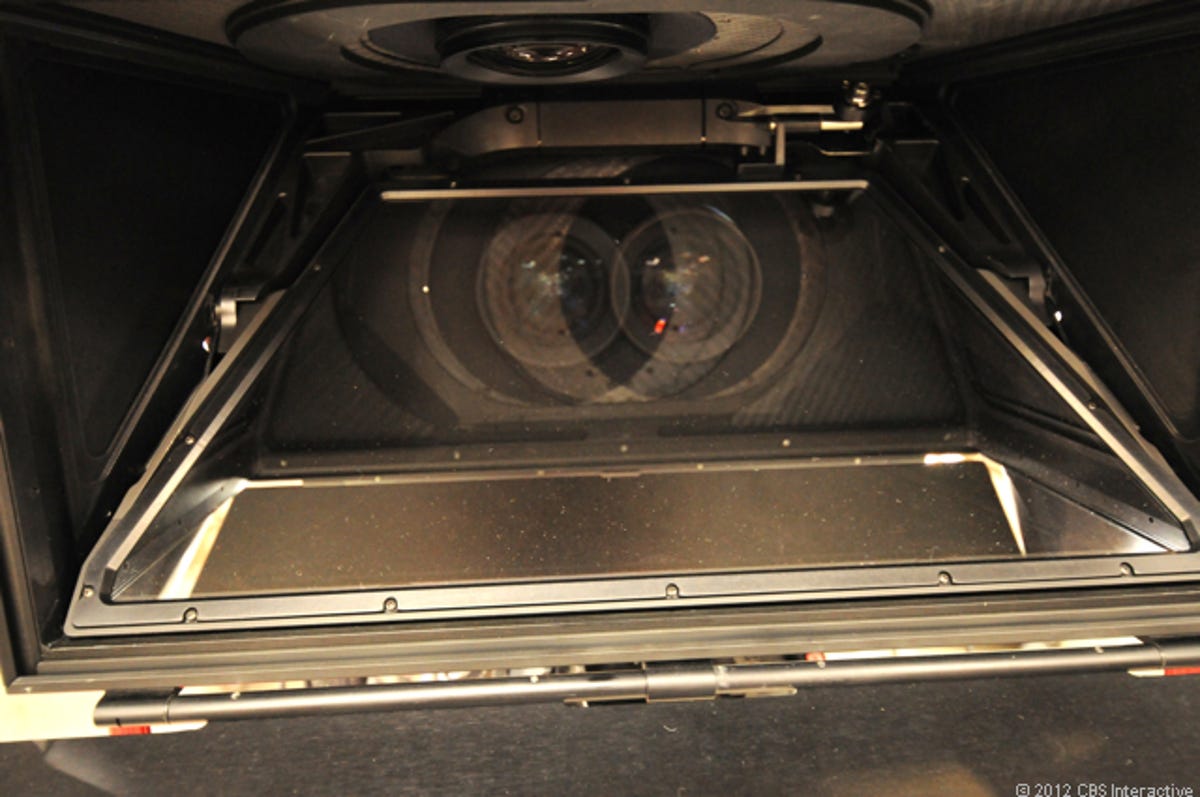The world's most bleeding-edge tech for making 3D movies (pictures)
More and more movies are being made in 3D today. A leader in the field is 3ality, whose technology for creating simple and accurate 3D pictures is the industry's most advanced. CNET Road Trip 2012 checked it out.

Helix lenses apart
BURBANK, Calif.--If the folks at 3ality Technica have their way, no one will ever again get nauseated again watching a 3D movie. And with the company's latest gear, the Helix, that may well be true.
The new gear features what is almost certainly the most advanced beam splitter in the business, and one the company expects most major Hollywood 3D film projects -- as well as live concert films, 3D TV projects, and others -- to be using in the near future.
With the Helix, everything is robotically controlled, including its operating lenses. It mounts two cameras -- one facing down, another shooting through -- a configuration known as over-and-through. And though 3ality's previous rigs have also offered that configuration, none have offered filmmakers the level of automation that the Helix does.
Here, we see the Helix configured for a 3D shot with a fair amount of depth, because of the distance between the two lenses.
Helix full
A look at the Helix, seen standing up in 3ality's Burbank, Calif., offices. The new rig's beam splitting system is designed to give 3D filmmakers a great deal of automation and the ability to use it with any kind of camera or lens without worrying about the physical mount. It can be taken apart and put back together in a wide variety of configurations, all very quickly and very easily, 3ality says. "Stereoscopic systems are precision tools designed to align two cameras to a sub-pixel level of accuracy," according to the company's Web site. "The 3alityTechnica family of tools enables creative producers, directors and cinematographers to create 3D on the same schedule they’ve established for their 2D productions."
Lenses apart
Seen here, the Helix is set to film a 3D shot with a significant amount of depth, as demonstrated by the distance between the two lenses. In actuality, what is seen here is a reflection of the downward-facing camera in the rig's mirror.
Lenses together
Here, the Helix has been set for what would essentially be a 2D shot, with its two lenses oriented the same way. The imagery captured by the two lenses would have no depth.
Over and through
This configuration is known as over-and-through, since one camera is pointed down and the second is pointed directly ahead. Feature filmmakers like this because the rig is easy to use with a Steadicam. Another orientation is called under-and-through and has the second camera pointing up from below. Sports cameramen like that approach because they can sit behind the rig and look at their monitors, something that doesn't work in the over-and-through orientation since the downward pointing camera gets in the way of their view.
Rear view
A look at the rear of the Helix, including at the two small video monitors showing the view from each camera.
3D view from TS-5
This is a 3D view taken by a 3ality TS-5 stereoscopic rig. This is what the cameras are capturing, although viewers wouldn't see the image as fuzzy because they'd be wearing 3D glasses.
3D representation
This monitor is showing a representation of the 3D picture from the previous slide. This view is intended to allow a 3D engineer to easily tell the depth of a shot. Software from 3ality gives the 3D engineer a large palette of controls and tools, including one (not seen here) that imposes a grid on this screen, giving an easy way to see the percentage of depth between the pictures from the two cameras. At most, 3D shots should have 2 percent depth.
Helix business side
A look at the Helix's automated systems, which turn many tools formerly requiring manual control over to small robotic motors, such as the operation of the focus, iris, and zoom of the two lenses.
TS-5 front
A look at the front end of a TS-5, set up in the under-and-through configuration preferred by sports cameramen.
Atom
This is 3ality's older Atom 3D rig, in the exact configuration used by "Prometheus" director Ridley Scott. Since this rig was released a couple of years ago, 3ality's technology has added a great deal of new tools and automation.
Atom over and through
A close-up of the downward-facing camera that is part of this over-and-through Atom configuration.
Helix controls
The camera operator behind this Helix gear would simply rotate these controls to modify the depth of the 3D when they're shooting.
TS-5 straight-on
A look straight into the TS-5, which in this picture, appears to be set for a 3D shot with medium depth.
SIP in a rack
The magic behind 3ality's systems is its stereo image processor, seen here installed in a rack of 3ality gear. It's the thin black blade with the light blue screen and the and the bank of eight small lights. The SIP "provides a number of functions designed to optimize the stereoscopic image pair," according to 3ality. "The simple, integrated Web-based interface provides the user -- whether it's the stereographer on a live shoot, an editor in a post-production house, or the quality assurance operator in a broadcast center -- with complete stereo information for every shot. When integrated with 3ality Technica's precisely automated rigs in production environments, corrections are applied dynamically, resulting in near pixel-perfect S3D imagery right from the camera."

